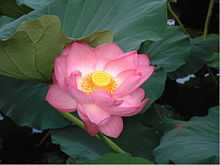Flower Sermon
| Part of a series on |
| Zen Buddhism |
|---|
 |
|
Main articles
|
|
Persons Chán in China
Zen in Japan
Seon in Korea Zen in the USA
|
|
Doctrines |
|
Awakening
|
|
Teachings
|
|
Practice |
|
Related schools |

Among adherents of Zen, the origin of Zen Buddhism is ascribed to a story, known in English as the Flower Sermon, in which Śākyamuni Buddha (Siddhartha Gautama) transmits direct prajñā (wisdom) to the disciple Mahākāśyapa. In the original Sino-Japanese, the story is called nengemishō (拈花微笑, literally "pick up flower, subtle smile"). In the story, Śākyamuni gives a wordless sermon to his disciples (sangha) by holding up a white flower. No one in the audience understands the Flower Sermon except Mahākāśyapa, who smiles. Within Zen, the Flower Sermon communicates the ineffable nature of tathātā (suchness) and Mahākāśyapa's smile signifies the direct transmission of wisdom without words. Śākyamuni affirmed this by saying:
I possess the true Dharma eye, the marvelous mind of Nirvana, the true form of the formless, the subtle [D]harma [G]ate that does not rest on words or letters but is a special transmission outside of the scriptures. This I entrust to Mahākāśyapa.[1]
Zen developed as a form of Buddhism that concentrated on direct experience rather than creeds, doctrines, or intellectual analysis. Zen is essentially an exploratory methodology for mapping consciousness, a meditative tradition that foregrounds direct experience of tathātā which may only be afforded by the entrance of the "gateless" Dharma Gate.[2]
Jung and Kerényi demonstrate a possible commonality in intent between the Flower Sermon and the Eleusinian Mysteries:
One day the Buddha silently held up a flower before the assembled throng of his disciples. This was the famous "Flower Sermon." Formally speaking, much the same thing happened in Eleusis when a mown ear of grain was silently shown. Even if our interpretation of this symbol is erroneous, the fact remains that a mown ear was shown in the course of the mysteries and that this kind of "wordless sermon" was the sole form of instruction in Eleusis which we may assume with certainty.[3]
The story of the Flower Sermon may have been created by Chinese Chán Buddhists.[4]
See also
- Chhatra
- Indra's net
- Linji Yixuan
- Mahayana
- Mahayana sutras
- Platform Sutra
- Southern School
- Vimalakirti
Notes
- ↑ Heinrich Dumoulin (2005). Zen Buddhism: a history. p. 9. ISBN 0-941532-89-5.
- ↑ Great religions of the world. Center for Distance Learning. Tarrant County College District, p.11
- ↑ Jung, C. G. & Kerényi, C. (2005). Essays on a Science of Mythology: The Myth of the Divine Child and the Mysteries of Eleusis. Routledge; 2 edition. ISBN 0-415-26742-0. Routledge, p. 179. Source: (accessed: November 28, 2007)
- ↑ William Harmless (2007). Mystics. Oxford University Press. p. 192.
References
- Welter, Albert. 2000. Mahākāśyapa’s Smile: Silent Transmission and the Kung-an (Kōan) Tradition. In The Kōan: Texts and Contexts in Zen Buddhism, edited by Steven Heine & Dale S. Wright. Oxford and New York: Oxford University Press, pp. 75–109.